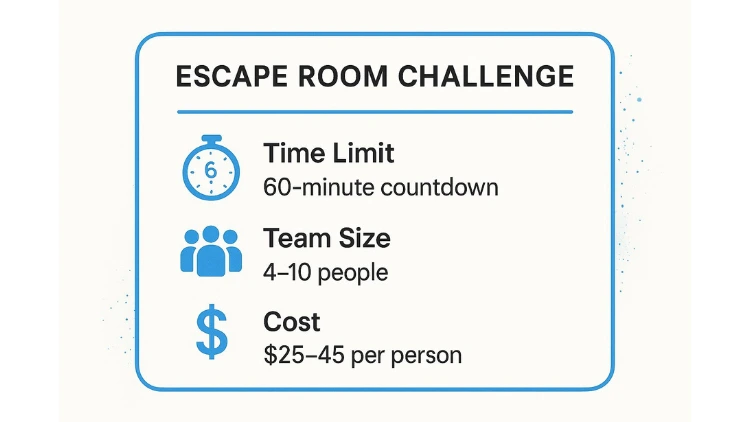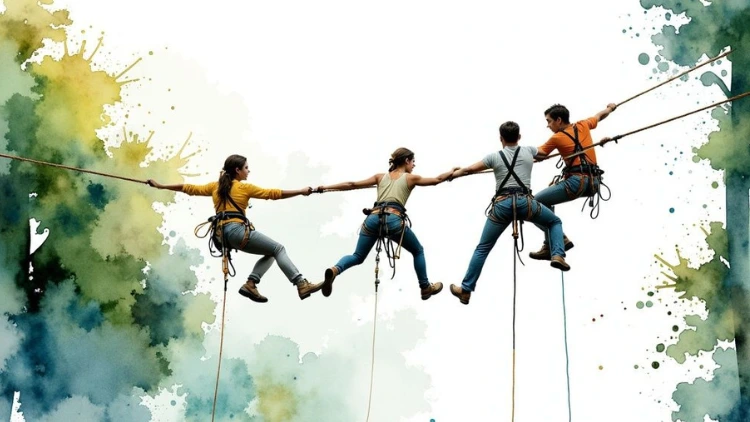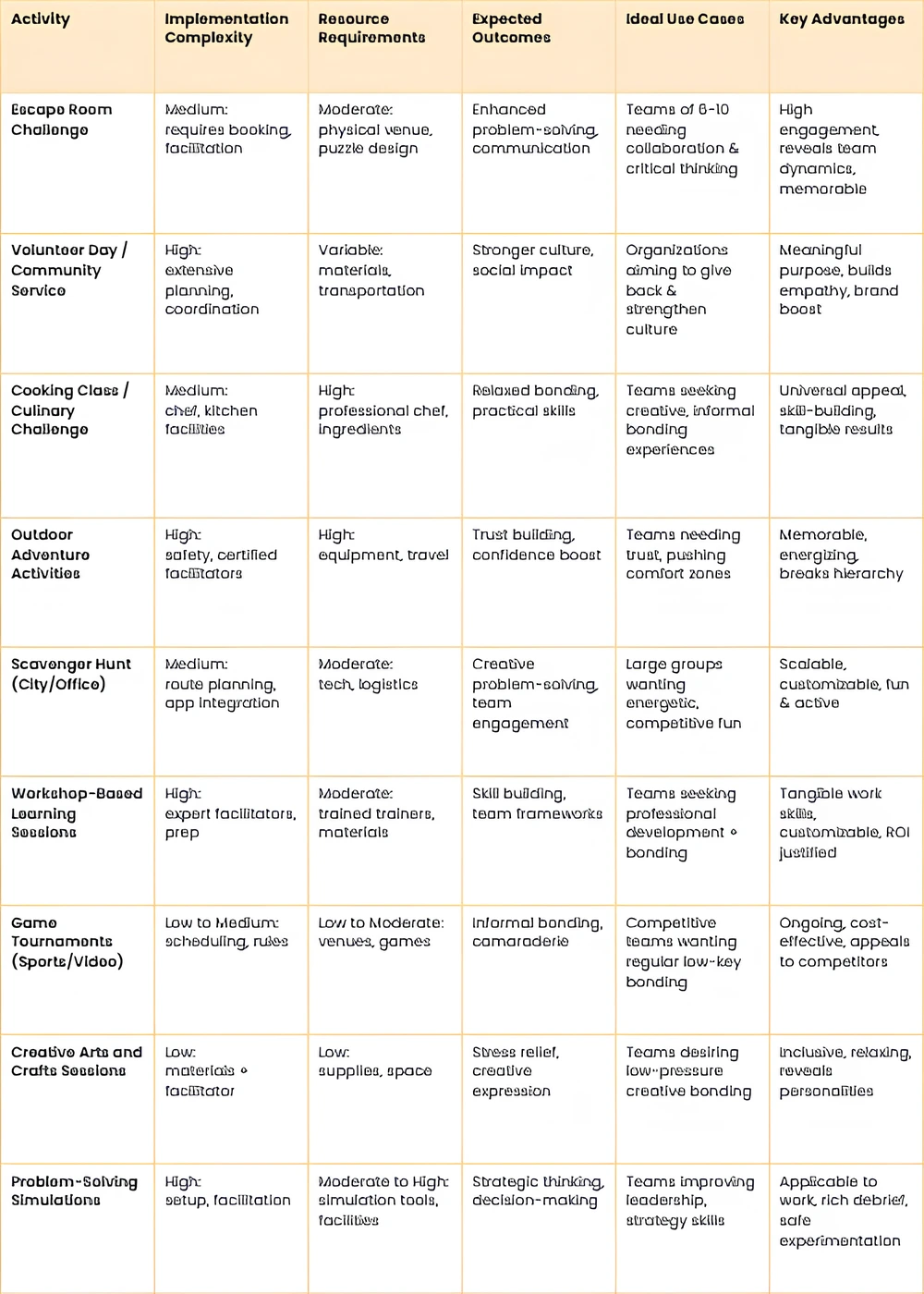9 Best Team Building Activities for Work in 2026

In today's dynamic workplace, fostering a connected, collaborative, and resilient team is more critical than ever. While daily stand-ups and project meetings are essential for operations, they rarely build the deep trust and innovative spirit that define high-performing teams. This is where strategic team building activities for work come into play. They break down communication barriers, reveal hidden talents, and create shared experiences that translate into a more cohesive and effective work environment. These activities are powerful tools for enhancing problem-solving skills and reinforcing a positive company culture year-round. For instance, the holiday season offers a prime opportunity to engage in Top Holiday Team Building Activities designed to boost morale and foster connection.
This article moves beyond generic trust falls and offers a curated roundup of impactful activities, each with practical examples and actionable insights. You'll find a structured guide to implementing everything from outdoor adventures to creative workshops, complete with tips on facilitation and expected outcomes. Whether your team is remote, hybrid, or in-office, you'll discover fresh, engaging ideas designed to re-energize your workforce, strengthen interpersonal bonds, and drive tangible results that a typical conference room meeting simply cannot produce.
Jump To Section

Earn As You Learn
Earn 25% commission when your network purchase Uplyrn courses or subscribe to our annual membership. It’s the best thing ever. Next to learning,
of course.
1. Escape Room Challenge
An escape room is an immersive adventure game where a team is "locked" in a themed room and must collaboratively solve puzzles, find clues, and crack codes to complete a mission within a 60-minute time limit. This high-stakes, time-sensitive environment makes it one of the most effective team building activities for work, as it naturally fosters communication, critical thinking, and shared problem-solving under pressure. Success is impossible without every member contributing their unique perspective.
A practical example is a marketing team using a "spy thriller" themed escape room. To solve the puzzles, the data analyst might excel at spotting patterns, the copywriter could decipher word-based clues, and the project manager might naturally take charge of organizing the workflow—revealing how their diverse skills can be better integrated in daily projects.
How to Implement an Escape Room Activity
To maximize the benefits of an escape room, careful planning is key. Simply showing up isn't enough; strategic facilitation turns a fun outing into a valuable developmental experience.
- Choose the Right Theme and Difficulty: Select a theme that aligns with your team's interests and a difficulty level appropriate for their experience. A room that is too hard can be demoralizing, while one that is too easy won't be challenging.
- Mix Your Teams: If you have a larger group, book multiple rooms and deliberately mix members from different departments. This encourages cross-functional collaboration and breaks down organizational silos.
- Conduct a Post-Activity Debrief: This is the most crucial step. After the game, facilitate a discussion. An actionable insight from this is to ask specific questions like, "Who emerged as a natural leader?" or "At what point did our communication break down, and how did we fix it?" Then, challenge the team to apply one communication improvement to their next project meeting.
As the infographic highlights, escape rooms are accessible for most small-to-medium teams and fit within a reasonable budget, making them a high-impact, low-overhead option. This activity is perfect for teams that need to improve their collaborative problem-solving and decision-making skills.

2. Volunteer Day / Community Service Project
A volunteer day unites a team to contribute their time and effort to a charitable cause or community project. Activities can range from sorting donations at a food bank to cleaning up a local park, allowing employees to connect over a shared sense of purpose. This is one of the most meaningful team building activities for work because it shifts the focus from internal goals to external impact, fostering empathy, collaboration, and a collective sense of pride.
A practical example of this is a software engineering team volunteering to build a website for a local animal shelter. This project allows them to use their professional skills for a good cause, requiring project management, collaboration, and problem-solving outside the context of their usual corporate deadlines, which can renew their sense of purpose.
How to Implement a Volunteer Day Activity
To ensure a volunteer day is both impactful and well-received, it requires thoughtful organization beyond just picking a cause. A well-planned event can create lasting positive memories and strengthen team dynamics significantly.
- Align with Team Passions: Survey team members to identify causes they care about. This ensures genuine buy-in and enthusiasm. You can learn more about how to ask for better team building events to gather this feedback effectively.
- Partner with Established Organizations: Work with reputable non-profits like Habitat for Humanity or local shelters. They have the infrastructure to manage volunteers, ensuring your team's time is used effectively.
- Communicate Logistics Clearly: Provide all necessary details in advance, including the location, time, physical requirements, and what to wear. Arranging transportation or carpools can also remove a significant barrier to participation.
- Document and Share the Impact: Take photos and videos during the event. An actionable insight here is to create a dedicated Slack channel or internal newsletter segment to share these visuals and a summary from the non-profit about the tangible impact (e.g., "Our team sorted 5,000 lbs of food, providing 4,000 meals to local families"). This reinforces the shared accomplishment and its real-world value.
This activity is ideal for companies looking to strengthen their corporate social responsibility profile while building a more cohesive and purpose-driven team culture. It connects colleagues on a human level, outside the pressures of deadlines and deliverables.
3. Cooking Class or Culinary Challenge
A cooking class or culinary challenge brings teams together in the kitchen to prepare a meal under the guidance of a professional chef. This collaborative experience requires clear communication, role delegation, and time management as participants work together to follow recipes and present a finished dish. It's one of the most engaging team building activities for work because it transforms a universal activity, cooking, into a platform for practicing teamwork and creativity in a fun, sensory-rich environment.
As a practical example, picture a sales team participating in a "Top Chef" style challenge where they are divided into groups and must create an appetizer using a set of mystery ingredients. This forces them to strategize quickly, delegate tasks (chopping, sautéing, plating), and communicate clearly under a time crunch, mirroring the fast-paced nature of a sales cycle.
How to Implement a Cooking Class Activity
To ensure a culinary event is both enjoyable and impactful, focus on preparation and engagement. The goal is to create a seamless experience where the focus remains on collaboration, not logistical hurdles.
- Gather Dietary Information Early: Collect all dietary restrictions and allergies well in advance to ensure the menu is inclusive and everyone can participate safely and fully.
- Choose Collaborative Recipes: Select dishes that require multiple steps or stations, like making pasta from scratch or assembling complex appetizers. This naturally encourages team members to divide tasks and rely on each other.
- Incorporate a Competitive Element: Introduce a friendly competition with judging based on taste, presentation, and teamwork. This adds excitement and motivates teams to communicate effectively. An actionable insight is to make "teamwork" a scored category, where the chef observes how well teams communicated and helped each other, providing specific feedback during the judging.
The shared accomplishment of creating a delicious meal together provides a tangible and rewarding outcome, making this an ideal activity for teams needing to improve communication and build stronger interpersonal bonds in a relaxed setting.

4. Outdoor Adventure Activities
Outdoor adventure activities encompass physical challenges like ropes courses, zip-lining, and white-water rafting that push teams out of their comfort zones in a controlled environment. These exhilarating experiences are powerful team building activities for work because they dismantle hierarchies and force reliance on trust, mutual support, and clear communication to overcome tangible obstacles. Navigating a real-world challenge together creates strong bonds and a shared sense of accomplishment.
A practical example is a leadership team tackling a high-ropes course. The CEO might struggle with a specific obstacle, requiring encouragement and guidance from a junior team member. This experience physically demonstrates the importance of relying on the entire team's strengths, regardless of job title, breaking down hierarchical barriers in a memorable way.
How to Implement Outdoor Adventure Activities
To ensure an outdoor adventure is both safe and impactful, thoughtful preparation is non-negotiable. The goal is a memorable growth experience, not a stressful ordeal, which requires careful logistical and psychological planning.
- Prioritize Safety and Inclusivity: Partner with certified, insured providers. Crucially, make participation optional and offer alternative roles like "official photographer" or "base camp coordinator" so no one feels pressured or excluded.
- Match the Challenge to the Team: Consider the physical fitness levels and comfort zones of your group when selecting an activity. A demanding multi-day hike may be perfect for one team but demoralizing for another.
- Facilitate a Reflection Session: After the event, lead a discussion. An actionable insight is to ask, "Think of a moment you felt stuck. Who helped you, and how did they do it?" Then, create a team pledge to replicate that supportive behavior during high-pressure projects back at the office.
These activities require a higher budget and more planning but deliver unparalleled results in building trust and resilience. This option is ideal for teams needing to strengthen interpersonal bonds, improve communication under pressure, and foster a culture of mutual reliance.

5. Scavenger Hunt (City or Office-Based)
A scavenger hunt sends teams on a mission to solve clues, find specific items, and complete creative challenges within a defined area and time limit. Modern versions leverage smartphone apps to track progress, verify tasks with photo evidence, and add multimedia elements. This dynamic format makes it one of the most versatile team building activities for work, encouraging strategic planning, resourcefulness, and time management in a fun, competitive environment.
A practical example is an office-based hunt for a newly onboarded team. Clues can be designed to lead them to different departments, requiring them to interact with key personnel (e.g., "Find the person who can approve a PO and get their signature"). This turns a fun game into a practical orientation session, helping new hires learn names, roles, and processes organically.
How to Implement a Scavenger Hunt
A successful scavenger hunt requires more than just a list of tasks; it needs thoughtful design to ensure engagement and smooth execution. Proper planning transforms a simple game into a powerful team-building tool.
- Customize Your Challenges: Tailor the hunt to your goals. Incorporate company trivia, brand values, or office-specific inside jokes. A mix of challenge types, such as photo ops, trivia questions, and problem-solving tasks, keeps the energy high.
- Leverage Technology: Use apps like GooseChase or Scavify to streamline the process. These platforms manage submissions, automate scoring, and provide a live leaderboard, which adds an exciting competitive element.
- Establish Clear Rules and a Home Base: Set clear geographical boundaries and a firm time limit. An actionable insight is to create a "bonus points" category for the most creative photo submission or the team that best demonstrates one of the company's core values, encouraging participants to think beyond simply completing the list.
The scavenger hunt is an excellent choice for energizing teams, encouraging creative problem-solving, and fostering camaraderie outside the typical office setting. It's highly adaptable for different group sizes, locations, and budgets.
6. Workshop-Based Learning Sessions
Workshop-based learning sessions are structured educational events where teams learn new skills together in an interactive environment. Unlike passive lectures, these workshops use hands-on exercises, discussions, and shared experiences to build both individual competencies and collective team bonds. This approach makes learning one of the most productive team building activities for work, as it addresses specific team challenges while fostering a culture of continuous improvement.
For a practical example, a customer support team could attend a workshop on "Effective Communication for De-escalation". Instead of a lecture, they engage in role-playing exercises with realistic customer scenarios. This allows them to practice techniques together, get immediate peer feedback, and develop a unified, empathetic approach to handling difficult situations.
How to Implement Workshop-Based Learning Sessions
To ensure a workshop translates into tangible workplace improvements, the design and facilitation must be deliberate. A well-executed session is more than just a training day; it’s an investment in your team’s collective potential. To truly engage teams and enhance skill acquisition in workshops, understanding what is immersive learning and how AR/VR training can transform skills can offer a cutting-edge advantage.
- Address Real Pain Points: Get team input on topics they want to explore. Choose a subject, like conflict resolution or public speaking, that directly addresses a current challenge or growth area.
- Prioritize Interaction: Design the session around activities, not lectures. Use breakout groups, role-playing, and collaborative problem-solving exercises to keep participants engaged and learning from one another.
- Create Actionable Takeaways: End the workshop by having the team create a concrete plan. A key actionable insight is to create a "commitment chart" where each team member writes down one specific behavior they will change based on the workshop, and the team agrees to hold each other accountable with gentle reminders in the following weeks.
Workshops are ideal for teams looking to develop specific soft skills, overcome persistent dysfunctions, or align on new processes. By investing in shared growth, you build a more capable, cohesive, and resilient team. Discover more about creating impactful sessions by exploring these insights on workshops that work.
7. Game Tournaments (Sports or Video Games)
Organized competitive gaming events, whether physical sports like bowling or virtual video games, offer a dynamic way to boost team spirit. These tournaments leverage friendly competition to build camaraderie and reveal how team members strategize, communicate, and handle both victory and defeat in a low-stakes environment. This is one of the most versatile team building activities for work, accommodating a wide range of interests and physical abilities.
A practical example is a company-wide Mario Kart tournament. It's accessible to non-gamers and gamers alike, and the friendly competition can reveal hidden aspects of colleagues' personalities—the quiet accountant might be a fiercely competitive racer, sparking new conversations and breaking down departmental silos.
How to Implement a Game Tournament
A successful tournament is more about participation and fun than just winning. Proper organization ensures everyone feels included and the focus remains on team bonding.
- Offer Variety and Balance: Cater to diverse interests by offering a mix of activities. Include skill-based games like ping-pong, luck-based games like board games, and strategic virtual games. When forming teams, manually create balanced groups to encourage new interactions.
- Keep the Stakes Low: Emphasize participation over victory. Offer small, fun prizes for things like "Most Improved Player" or "Best Team Spirit" to ensure the atmosphere remains lighthearted.
- Facilitate Social Time: Schedule time before and after the tournament for unstructured mingling. An actionable insight is to set up a "spectator lounge" with snacks and drinks, so even those not actively playing can socialize and cheer for their colleagues, ensuring everyone is part of the shared experience.
Game tournaments are highly adaptable, making them suitable for both small groups and large-scale company-wide events. This activity is perfect for teams looking to boost morale, introduce a healthy dose of competition, and see how individuals perform in a structured but fun setting.
8. Creative Arts and Crafts Sessions
A creative arts and crafts session is a hands-on, collaborative activity where teams produce art together, such as group painting, pottery, or building sculptures. These sessions shift the focus from analytical work to creative expression, providing a low-pressure environment where colleagues can connect on a more personal level. As one of the more relaxed team building activities for work, it emphasizes process over outcome, encouraging communication and shared accomplishment.
A practical example of this is a team-building session where each member decorates a ceramic tile representing a core company value. The individual tiles are then assembled into a single mosaic and displayed in the office. This creates a lasting, physical representation of their collective identity and shared principles.
How to Implement a Creative Arts and Crafts Session
To ensure a creative session is both enjoyable and impactful, it's important to facilitate an inclusive and relaxed atmosphere. The goal is to unlock creative potential, not to judge artistic talent.
- Choose an Accessible Project: Select an activity like a "Paint Nite" style class, a ceramics workshop, or a collaborative mural that doesn't require prior artistic skill. The key is participation, not perfection.
- Encourage Collaboration and Individuality: Structure the activity to allow for both. A group quilt or mural lets everyone contribute to a single piece, while individual pottery or painting can be tied together with a common theme.
- Set a Relaxed Tone: Create a comfortable environment with music and refreshments. Provide smocks or old shirts to remove any concerns about messiness, allowing team members to fully engage without worry.
- Debrief on the Creative Process: After the activity, discuss the experience. An actionable insight is to ask, "What was it like to work on a project with no single 'right' answer?" and then brainstorm ways to bring that same creative freedom and psychological safety to the team's next brainstorming session, helping to find inspiration and spark creativity back in the office.
This activity is ideal for teams needing a break from high-stress analytical tasks or for groups looking to improve their creative thinking and build stronger interpersonal bonds in a non-competitive setting. Displaying the finished art in the office serves as a lasting reminder of the team's shared experience.
9. Problem-Solving Simulations and Business Games
Problem-solving simulations are structured business games where teams tackle complex case studies or manage virtual companies, mirroring real-world challenges. Activities like the classic Marshmallow Challenge or intricate supply chain simulations push teams to think strategically, allocate resources, and adapt to changing conditions. This makes them one of the most effective team building activities for work, as they reveal a team's decision-making processes in a controlled, low-stakes environment.
A practical example is the "Desert Survival" simulation. A team must rank a list of salvaged items in order of importance for survival after a plane crash. This exercise quickly reveals the group's decision-making style: do they vote, does one person dominate, or do they build consensus through logical debate? The outcome provides a clear mirror to their project planning dynamics.
How to Implement a Problem-Solving Simulation
To ensure a simulation translates into tangible workplace improvements, facilitation and debriefing are just as important as the activity itself. A well-run simulation is an interactive learning lab, not just a game.
- Select the Right Simulation: Choose a game that reflects your team's specific challenges. A marketing team might benefit from a brand management simulation, while an engineering team could tackle a project management scenario.
- Rotate Leadership Roles: If the simulation involves multiple rounds, assign a different leader for each one. This gives various team members a chance to lead and allows the team to experience different leadership styles.
- Facilitate a Thorough Debrief: This is the most critical component. An actionable insight is to have the team map their simulation process (e.g., initial planning, execution, crisis response) and then compare it to their last real-world project. Ask: "Where are the parallels? What breakdown in the game also happens at work, and what's one process change we can make next week to fix it?" to improve problem-solving skills.
Simulations are ideal for teams that need to enhance their strategic thinking, cross-functional communication, and ability to navigate complex business challenges. They offer a dynamic and engaging way to practice critical skills that are directly applicable to achieving organizational goals.
Team Building Activities Comparison Matrix

From Activity to Action: Making Team Building Stick
We’ve explored a diverse range of team building activities for work, from the high-stakes collaboration of an Escape Room Challenge to the creative expression of an arts and crafts session. Each offers a unique pathway to stronger team bonds, improved communication, and a more vibrant workplace culture. But the true measure of success isn't the fun had during the event itself; it's the positive, lasting change that follows. The real value is unlocked when the lessons learned are consciously integrated back into daily workflows.
The ultimate goal of any team building initiative is to transform a group of individuals into a cohesive, high-performing unit. The activities in this guide, whether a Community Service Project or a Problem-Solving Simulation, are simply the catalysts for this transformation. They provide a unique, low-pressure environment where team members can practice vital skills, discover new things about their colleagues, and build the psychological safety necessary for true collaboration.
Turning Moments into Momentum
To ensure your investment delivers a powerful return, you must bridge the gap between the activity and everyday action. Without a clear strategy for follow-through, even the most engaging event will become a pleasant but distant memory. The key is to be intentional both before and after the event.
- Before the Activity: Set a Clear Purpose. Before you book a cooking class or organize a scavenger hunt, ask your team: What specific outcome are we aiming for? Is the goal to improve communication between the marketing and sales teams, enhance creative problem-solving skills for a new project, or simply to celebrate a recent success and boost morale? Defining your "why" will guide your choice of activity and help frame the experience for everyone involved.
- After the Activity: Facilitate a Meaningful Debrief. This is the most critical step. Gather your team afterward to discuss the experience. Ask targeted questions: "What did we learn about our communication style during the Escape Room?" or "How can we apply the collaborative spirit from our volunteer day to our Q4 project?" This conversation is where abstract feelings become concrete insights.
Creating an Action Plan for Lasting Impact
The insights from the debrief session must be translated into tangible next steps. This doesn't need to be a complex, formal document. A simple, co-created action plan can make all the difference.
For example, if the debrief revealed that one person tended to dominate the problem-solving simulation, the team might agree on an action item: "During our weekly project meetings, we will use a round-robin format for the first 10 minutes to ensure everyone's initial ideas are heard". This is a practical, measurable change directly inspired by the team building activity. By linking the shared experience to a specific behavioral adjustment, you make the lesson stick. These small, consistent changes are what build a foundation of trust, respect, and effective collaboration over time. Ultimately, the best team building activities for work are those that equip your team not just with a fun memory, but with actionable strategies to excel together long after the event is over.
Ready to take your team's skills to the next level? The principles of collaboration, communication, and problem-solving are core to professional growth. Explore the expert-led courses on Uplyrn to provide your team with continuous development opportunities that reinforce the very skills you're building. Visit Uplyrn to discover programs that can turn team building insights into lasting professional expertise.


Leave your thoughts here...
All Comments
Reply